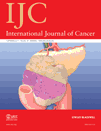Carcinogenetic risk estimation based on quantification of DNA methylation levels in liver tissue at the precancerous stage
Abstract
For appropriate surveillance of patients at the precancerous stage for hepatocellular carcinomas (HCCs), carcinogenetic risk estimation is advantageous. The aim of our study was to establish criteria for such estimation based on DNA methylation profiling. The DNA methylation status of 203 CpG sites on 25 bacterial artificial chromosome (BAC) clones, whose DNA methylation status had been proven to discriminate samples of noncancerous liver tissue obtained from patients with HCC (N) from normal liver tissue (C) samples by BAC array-based methylated CpG island amplification, was evaluated quantitatively using pyrosequencing. The 45 CpG sites whose DNA methylation levels differed significantly between C and N in the learning cohort (n = 22) were identified. The criteria combining DNA methylation status for the 30 regions including the 45 CpG sites were able to diagnose N as being at high risk of carcinogenesis with 100% sensitivity and specificity in the learning cohort and 95.6% sensitivity and 100% specificity in the validation (n = 90) cohort. DNA methylation status for the 30 regions in N samples was significantly correlated with the outcome of patients with HCCs, indicating that clinicopathologically valid DNA methylation alterations have already accumulated at the precancerous stage. The DNA methylation status of the 30 regions did not depend on the presence or absence of hepatitis virus infection, or the status of noncancerous liver tissue (chronic hepatitis or cirrhosis). These criteria may be applicable for carcinogenetic risk estimation using liver biopsy specimens obtained from patients who are followed up because of chronic liver diseases.




